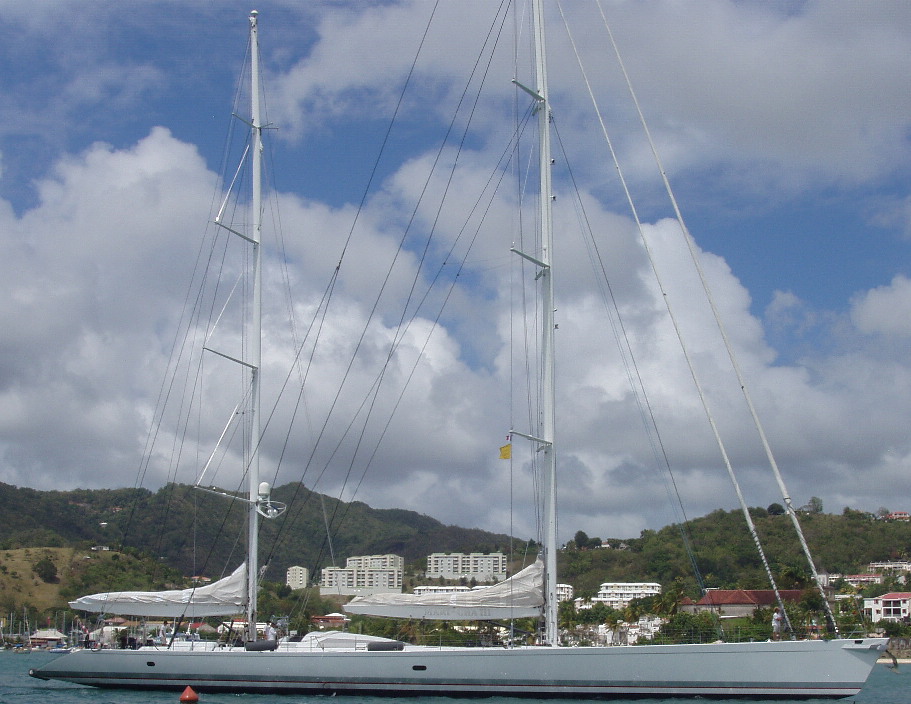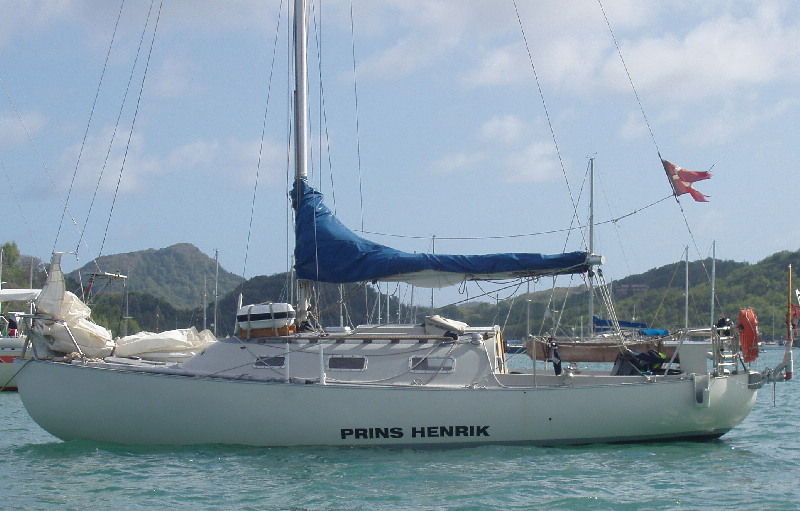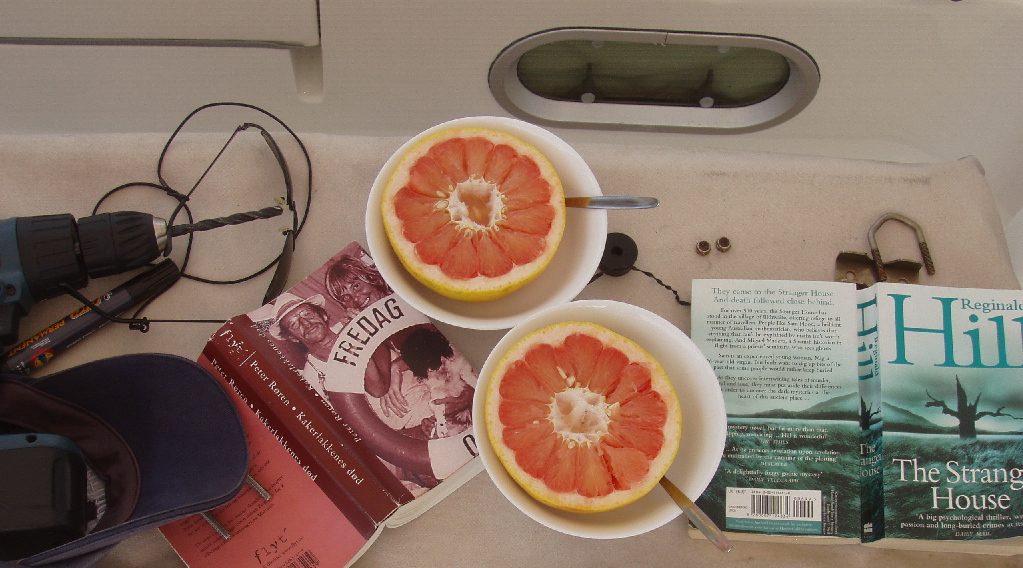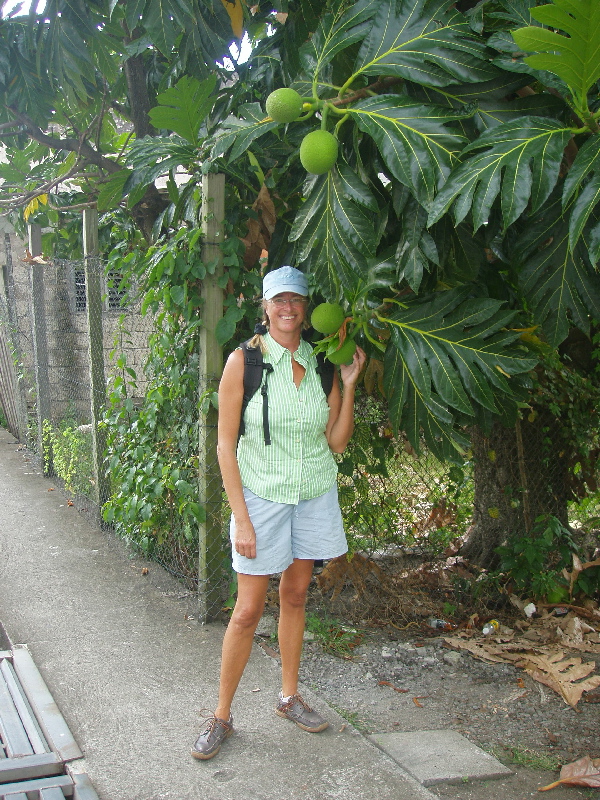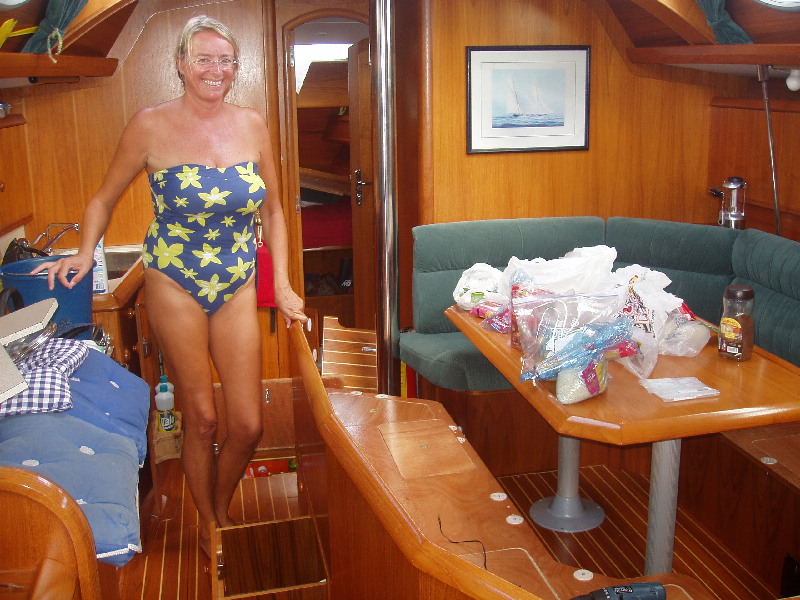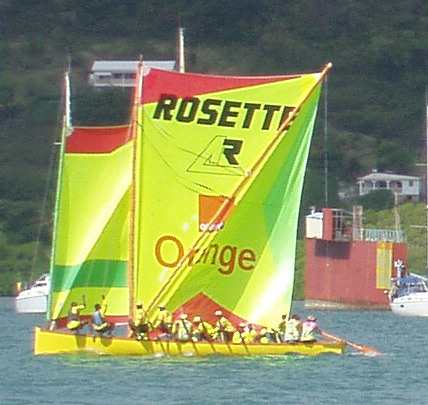Date: 16-02-07 Time: 17:00 UTC Position: 14:27.93N 060:52.19W Name: Le Marin, Martinique
Nå har vi vært på Martinique i en ukes tid - men ikke sett så mye pga. alt
tullet med spinnakerbommen. Jeg kan skrive litt om det vi har sett (og lest,
blitt fortalt osv) og legger ved bilder siden vi skal inn til en internett-café
senere i dag.
Veiene her på Martinique er gode - det står skilt overalt som forklarer at
veiprosjektet er sponsed av EU. Skiltingen forøvrig er meget bra - som i
Frankrike. Her i Le Marin er det sikkert flere veiskilt enn på hele St. Lucia.
Bilene er små - Renault Clio, Fiat Uno - den slags størelse. Det er noen få
større firehjulstrekkere, men ikke i den grad som at nesten alle biler er
pickup'er eler 4x4'er på Bequia eller St. Lucia - der veiene er så dårlig
at man må nesten ha en firehjulstrekker. Kjørestilen er mer europeisk -
ikke så mye "tut-og-kjør" som ellers her. Befolkning er like mye europeisk
som karibisk atferds- og kulturmessig - og utrolig fransk. Det er ca.
400.000 innbyggere på Martinique og 10% av disse er "Békés" - hvite etterkommere
av plantasjeeiere og andre utvandrede europeere. Det er også et indisk tilslag
og en god del av blandet rase. Det kan ikke være så mye arbeidsledighet fordi
her ser man ikke folk som bare henger på gatehjørnene hele dagen.
Restaurantnæring og butikkene har mest Békés som ansatte, mens matbutikkene har
mest afrikanske etterkommere som ansatte. Engelsk snakkes av relativt få men
forstås av flere enn som er villig til å innrømme det. Jeg har prøvd meg med
litt fransk til en som sa at han ikke forstod engelsk, men etterhvert som min
skolefransk kom til kort i forklaringsprosessen kunne jeg bruke engelske ord som
han forstod bedre enn min dårlige fransk! Her må man hilse pent "Bonjour" før
man skal sette igang en samtale. Mannen som er deleier i båtutstyrsbutikken
snakker bra engelsk. Jeg har vært i butikken mange ganger og jeg er sikker på at
han husker meg (den plagsomme mannen uten spinnakerbom). Allikevel prater han
alltid fransk til meg til å begynne med og for å hilse adjø. Han vil heller ikke
si hvoe mye regningen er på engelsk fordi han vet at jeg forstår tallene på
fransk.
Her i Le Marin er det plass for både store båter og små. Avbildet øverst er
Mari-Cha III - en lekker skute med mannskap på fire. Merk i bakgrunnene blokkene
som ligner veldig på Lamberseter. Små båter er det bedre plass til også - og på
lik linje med Frankrike er båtene her mye mindre enn man ser ellers i Karibia -
fordi disse eies av lokalbefolkningen og ikke turister som oss. En typisk fransk
båt er rundt 30 for med brukbar plass til to, men med åtte ombord.
Amerikanske båter er rundt 55 fot med veldig god plass til 8, men bare to
ombord! Vi traff en dansk båt "Prins Henrik" i dag - de var nettopp kommet fra
Kapp Verde og vi invitterte dem over for Sundowners. Det viste seg at de kjenner
Inger-Lise - vår danske venninne som seilte med oss fra Portugal til Madeira.
Deres båt er kun 24 fot lang! Se bilder nummer 2.
Hvordan får vi dagene til å gå her mens vi venter på spinnakerbommen spør
du? Frokost iallfall varer i godt over en time. Det begynner med en kopp te før
vi spiser. Etter teen blir det litt mat - i bilde nummer 3 er det grapefrukt som
skal fortæres. Etter maten blir det en kopp kaffe. Alt inntas sammen med godt
lesestoff eller litt mekking på båten. Å sanke mat kan ta litt tid også - her
handler man ikke for en hel uke på super'n på en lørdag. Det blir en tur i
butikken hver dag når vi ligger i havn - eller som i bilde #4 er det bare å
plukke et brødfrukt rett fra treet. Et annet fornuftig tidsfordriv er jakt. Ikke
rypejakt som vi har som hobby hjemme, men kakerlakkjakt. Premissene er det samme
- prøv å lire seg overraskende inn på dyrene og drepe dem med det du har
tilgjengelig (børse anbefales ikke om bord, så kjemisk krikføring er den
foretrukne metoden). Se bilde #5. Ellers kan man underholdes av lokale
regattabåter som jeg refererte til for noen dager siden - båter uten kjøl og
ballast, men et stort mannskap som henger ut på flyttbare planker - se bilde
#6.
1. Mari Cha III - litt av en båt! Merk
blokkleilighetene som ligner Lamberseter i bakgrunnen.
1. Mari Cha III - quite a nice boat. Note the
blocks of flats in the background.
2. Denne danske båten er litt kortere enn Mari Cha
III - bare 24 fot og nylig ankommet over Atlanterhavet fra Kapp
Verde.
2. This Danish boat is shorter than Mari Cha III at
just 24 feet - just arrived from the Cape Verde Islands.
3. Frokost - Nydelig fersk grapefrukt, godt
lesestoff, verktøy og syrefast stål!
3. Breakfast - delicious grapefruit, good books,
electric drill and stainles steel parts.
4. Hvorfor kjøpe mat når det kan plukkes rett fra
treet? Her et brødfrukttre.
4. Why buy food when you can pick it straight from
the tree? Here a breadfruit tree.
5. Her endevender vi båten på jakt etter
kakerlakker - vi har sett og drept to, men man vet jo ikke om det er
flere.
5. Here we empty all drawers etc in the hunt for
cockroaches - we have seen and killed 2, but we do not know if there are
more.
6. Kroppsvekt er viktig for å hindre at båten
kantrer.
6. Moveable ballast in the form of lots of boidies
keeps these local boats from capsizing.
English version
After a week on Martinique we haven't seen all that much - due to the farce
of the spinnaker pole. As we are going to an internet café I will write a longer
entry than usual covering information about the island and our observations
here. One of the first things we noted were that the roads are in a very good
state of repair and seem to have a good network over the island. Despite this
(or because of it?) Martinique has the most congested traffic of all the
Caribbean islands. As in mainland Europe, there are signs everywhere stating
that this new road was sponsored by the EU (ie. British and Norwegian
taxpayers). The good roads mean that the 4x4's and pickups seen as the standard
transport on the other islands are replaced by small ordinary cars like the
Renault Clio, Fiat Uno etc. The quality of driving is also more European. The
signposting is excellent - the few roads and two roundabouts here in Le Marin
have more signposts than the whole of St. Lucia. The population as as European
as they are Caribbean in the way they behave. The island has 400.000 inhabitants
- the most populus of the small Caribbean Islands forming the Lesser Antilles
(the Greater Antilles are the big island further north and west of Jamaica,
Cuba, Haiti, Dominican Republic). About 10% are the "Békés" - white descendants
of the French plantation owners and other emigrant Europeans. There is also a
considerable Indian population and many of mixed race. There can't be much
unemployment as the usual crowds of predominantly black men who hang around on
the corners on the other islands just don't exist here. One sees in fact few
people on the streets at all. The restaurants and most other shops seem to be
owned and run by Békés whereas the food shops have predominantly Afro-Caribbean
workers. Relatively few speak English but I suspect that more people understand
a little than they let on about. I have tried to speak a little rusty schoolboy
French to one man who adamantly insisted that he knew no English. As my French
failed to explain my needs a few English words were slipped in - which helped
the conversation greatly and led to complete understanding. The man who seems to
be the boss at the chandler's known me quite well now after my innumerable
visits to the shop. He still starts out by speaking French to me; always uses
French for numbers and finishes a conversation in French, despite having spoken
near perfect English the rest of the time. Some French manners also go a long
way - always greet any person with whom you will want to speak with "Bonjour" or
they will not know that the conversation has begun and will thus ignore your
presence.
Le Marin is a big harbour with space for both large and small boats. The
top picture is of the impressive ketch Mari Cha III with her crew of four. Note
the rather ugly blocks of flats in the background which are more reminiscent of
a council estate from an inner city area built in the 1980's than of the
Caribbean. There is also room for small boats and like in France there are a lot
of smaller boats which one just doesn't see on the other islands - largely
because these boats are owned by the locals - predominantly Békés. A typical
French boat is about 30 feet, has reasonable space for two people but has eight
on board. A typical American boat is about 55 feet with very good space for
eight, but only two on board. We met a Danish boat who arrived yesterday and
invited them over for a sundowner. They have just arrived from the other side of
the Atlantic - the Cape Verde Islands - in their 24 footer, pictured in picture
#2.
Perhaps you wonder how we get the days to pass here? One of the secrets is
to ensure that breakfast lasts well over an hour. We always start with a cup of
tea before beginning to organize anything to eat. After the tea we will eat
something - in picture number 3 it is a delicious locally grown grapefruit.
After the food we make coffee. All of this is consumed together with a good book
or some maintenance project. Getting food is also a slower process here - no
Saturday trip to Tesco to stock up for a whole week for us! We buy food daily
when near a shop - or pick straight from a tree if available - see picture #4.
Another passtime which has filled one whole day is a good bit of hunting - not
the ptarmigan shooting we do at home, but hunting for cockroaches in the boat.
The idea is much the same, creep up on the poor defenceless animals until close
enough to be sure of a kill, then use whatever weapon you have at hand on them,
though use of a shotgun on board is not recommended. We have also resorted to
chemical warfare and using traps which seem to have wiped out the population
entirely. See picture #5. Otherwise there is always entertainment from other
boats arriving or leaving - of the local traditional sailboats which I referred
to last Sunday - no keel or ballast, so a large crew is used precariously
ballanced on long moveable planks to prevent the boat from capsizing. See
picture #6.
| 
